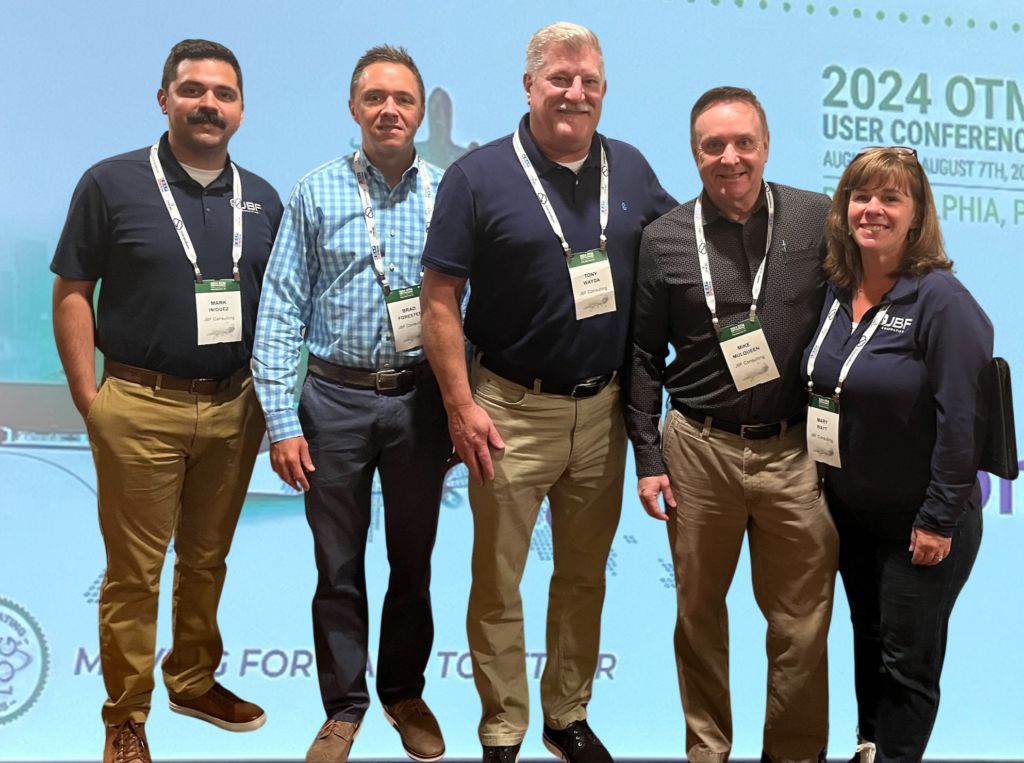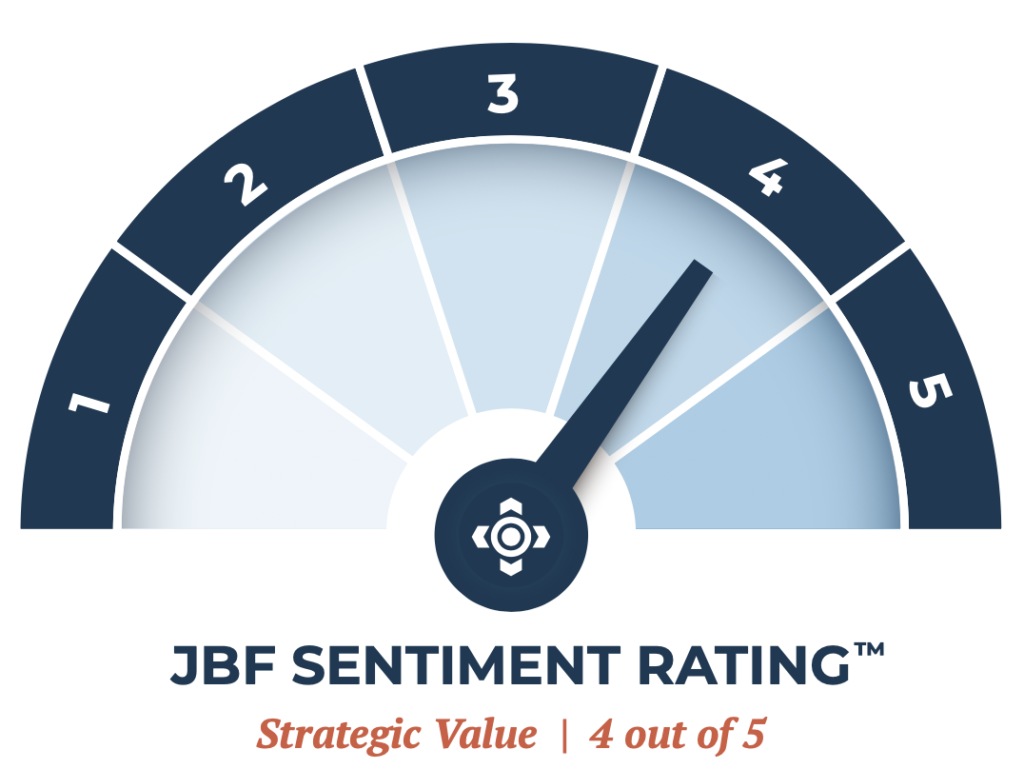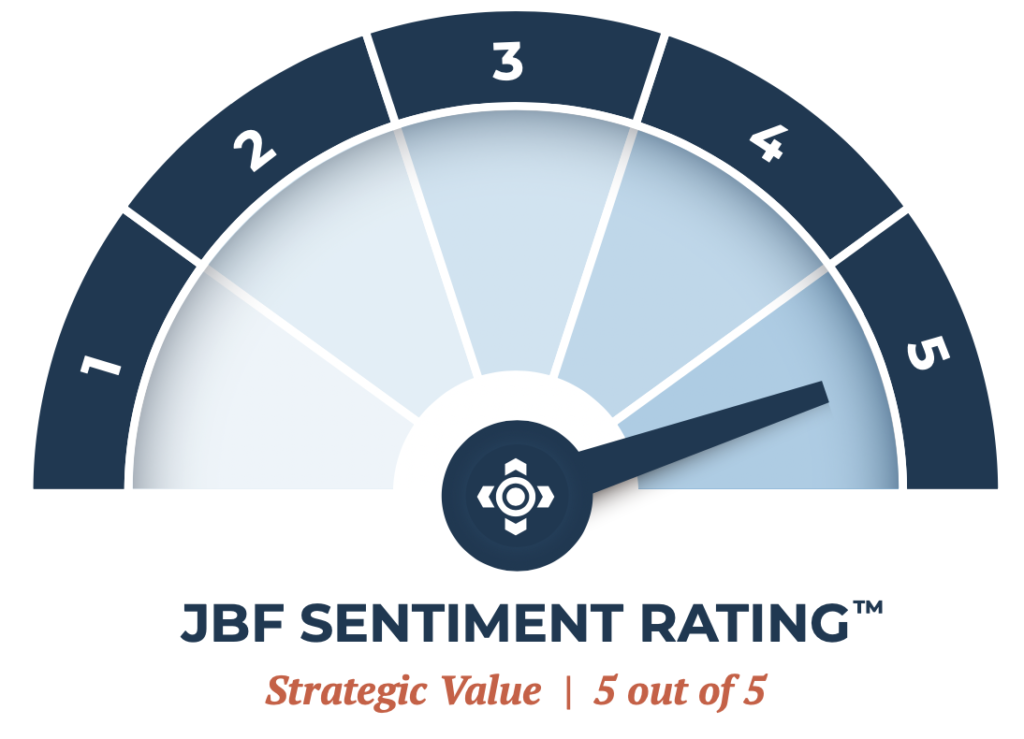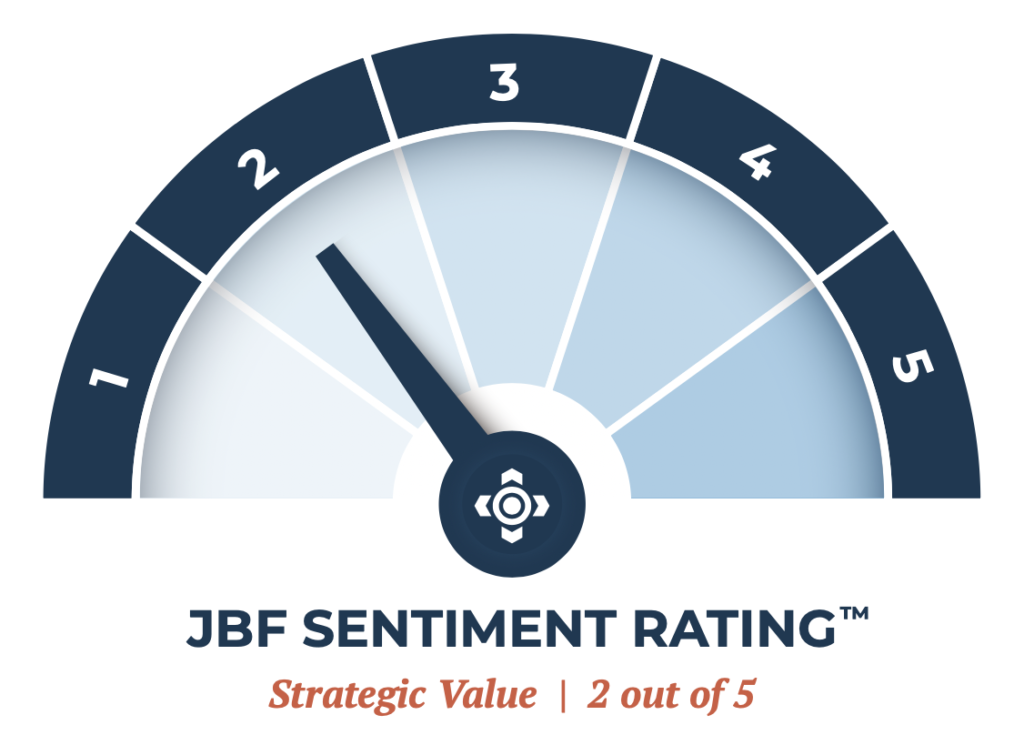Introduction
Recently, we attended the Oracle Transportation Management Special Interest Group (OTM-SIG) conference in Philadelphia. The conference, which highlighted the 25th anniversary of OTM (and its predecessor, G-Log), is unique in that it is NOT an Oracle event but instead is organized and run by OTM and Global Trade Management (GTM) clients. Oracle personnel, like other participants, need to pay to attend.
This year, there were approximately 450 attendees, including shippers, 3PLs, logistics technology providers, and system integrators. The SIG has gotten large enough that it has outgrown its traditional home in Philadelphia and is moving to a larger venue in Minneapolis next year.

Pictured here l-r: Mark Iniguez, Brad Forester, Tony Wayda, Mike Mulqueen, Mary Wayt
The fact that this is a client-run event, with many participants having a decade or more of experience with OTM, leads the content to be, at times, rather technical. Many presentations went very deep into application configuration and nuanced functionality that only advanced practitioners would know (or care) about.
While dry to the casual audience member, the conversations often evoked spirited discussions as attendees looked to use others’ experiences to extract more value from their own systems. Sales and marketing people fall asleep in these discussions, but they are invaluable to operators who need to understand the details (aka the “Hows”) to drive results back to the business.
"This conference provided valuable insights into what Oracle is doing regarding sustainability, fleet management, artificial intelligence, and application flexibility."
For this reason, the Oracle R&D team plays a critical role in this conference. Senior OTM/GTM leadership, including the founders of the predecessor to OTM (G-Log), sat in many of the presentations and were highly engaged. They discussed designs and use cases and listened intently, as we perceive this event provides an opportunity for Oracle to hear from a broad array of clients by providing them a venue to gather insights into market needs that are otherwise difficult to ascertain.
As attendees, we felt this conference provided valuable insights into what Oracle is doing regarding sustainability, fleet management, artificial intelligence, and application flexibility. However, details concerning their Oracle Business Network (OBN) were lacking, leaving questions about how it would support shipper collaboration.
Below are the 5 areas we found most interesting, both in terms of innovative capabilities and opportunities we would like to see further investment in.
Area 1 – Sustainability
Oracle has built emission calculators and reports that are used to capture and analyze an organization’s Scope 1, 2, and 3 freight emissions. The calculator can be configured to use various common frameworks (e.g. GLEC) to perform the calculations.
Oracle also touted the future ability to include emissions in the objective function of the optimizer, citing that emissions are now “intrinsic” to the shipment, similar to values such as weight and cost.
Sustainability and emissions reporting is becoming an important TMS requirement. In Europe, the Corporate Sustainability Reporting Directive is being phased in over the next few years and requires EU organizations to report their emissions. This capability will be critical for these companies, but JBF sees carbon emissions calculations as a growing need in North America as well. Effectively being able to measure emissions is the first step in developing a strategy to reduce them.
However, good transportation optimization is highly correlated to lower emissions. We struggle to understand how, aside from the carrier section, the revised optimization logic will impact planning. For example, a TMS will naturally select intermodal over truckload transportation, not due to emissions reductions but due to cost. Therefore, we are uncertain as to what effects emissions cognizant optimization will have on a solution.
Until now, we have only seen SAP offer explicit “emissions cognizant” optimization. We look forward to learning more about how the planning heuristics will be able to reduce emissions without impacting service times.
"The Oracle team articulated many of the challenges we see at JBF in terms of planning these types of [BEV] vehicles, including range variability driven by terrain, weather, and battery age."
On a related topic, Oracle is the first organization we have heard that is thinking about the impact on optimization when using a Battery Electric Vehicle (BEV) fleet. BEVs introduce complexities that are irrelevant when planning diesel vehicles. The Oracle team articulated many of the challenges we see at JBF in terms of planning these types of vehicles, including range variability driven by terrain, weather, and battery age.
Additionally, the range limitations and duration of charge times are major factors in how loads are built and which loads can be given to a BEV vehicle. While Oracle is still working on this problem, it was good to see they have a deep appreciation of the challenges that BEVs hold in transport optimization.
Area 2 – Fleet Management
Oracle continues to build out its fleet planning capabilities. Fleet planning in traditional TMS solutions has lagged that of pure-play routing and scheduling applications from best-of-breed providers like ORTEC, Descartes, LogiNext, and Omnitracs/Roadnet. This leads to lost opportunities where our designs require logic to direct which orders flow to the fleet routing system and which go to a TMS system. Naturally, this is sub-optimal, but it was necessary due to the deficiencies of TMS solutions.
Historically, the TMS providers have attempted to shoe-horn routing capabilities into their TMS by using the same optimization heuristics and rate/routing paradigms. However, fleet routing problems are fundamentally different than contract optimization problems, and a TMS that repurposes their multi-stop TL formation heuristics and rating designed for contract freight to also work for fleets has inevitably led to disappointed users.
Therefore, we were surprised when we attended a session where the primary use case presented by the shipper was high-density (10+ stops/truck) fleet routing and dispatching. The shipper had no LTL or TL freight. This problem falls squarely into the R&S vendor’s space, but the company in question uses OTM to manage this fleet routing problem very effectively.
In addition to the fleet route planning capabilities used, the shipper noted that the ability to effectively assess and perform post-optimization manipulation by the routing team has improved dramatically through advances in Oracle’s user interface (aka Workbench).
It was also stated that OTM can effectively determine the optimal mix of for-hire carriers versus a private fleet. The sunk cost nature of a fleet (private or dedicated), along with the need to manage driver hours and empty miles, make fleet planning uniquely challenging when attempting to compare contract versus fleet costs.
While all TMS solutions claim to be able to support this use case, in our work with leading providers, the results don’t match the sales pitch. It appears that Oracle may have cracked the nut, although we can’t say this definitively until we test the solution ourselves.
Area 3 – Artificial Intelligence
What is a log-tech write-up without the mention of AI/ML?
Access to the Oracle mothership provides the OTM team a significant advantage over other organizations that need to build this capability themselves.
For nearly a decade, Oracle has had natural language processing “ChatBots” to answer questions such as, “Where is my load?” They have also been harnessing machine learning techniques to perform predictive ETA calculations, which could reduce the need to outsource this capability to real-time visibility platforms such as FourKites, Shippeo, and Project44. We see these as primarily incremental productivity gains versus non-incremental, foundational changes to operations.
Oracle did discuss the use of AI Agents to automate certain processes. An example given was how these agents could be used to manage the appointment scheduling process. They also discussed customizable agents that can do mundane tasks, such as converting an email to an API or sending an email notification to a carrier based on the interpretation of unstructured data. We are eager to see how Oracle approaches these types of problems.
We appreciated Oracle’s perspective that AI needs to be embedded into the application and not require the shipper to have competencies in data science, neural networks, LLMs, or even data training. We agree that to maximize adoption, the appropriate various flavors of AI need to be integrated into the process with the underlying sophistication hidden from the end user.
"Access to the Oracle mothership provides the OTM team a significant advantage over other organizations that need to build this capability themselves."
Area 4 – Application Flexibility
People who do not work in freight transportation often don’t appreciate the complexity of freight operations for an enterprise shipper.
While conceptually, freight transport is simple to understand (optimally move stuff from A to B), the disparate ways it happens make planning and execution of freight exceedingly complex. Rating structures and operational constraints vary greatly by mode and geography, yet shippers expect their TMS to be able to optimally plan and execute all freight. Historically, this has not been the case, which has led to a variety of point solutions being built that address, very well, a portion of an enterprise’s needs.
However, the flexible nature of Oracle’s rating, coupled with optimization heuristics that are purpose-built for specific network problems, has made OTM much more flexible than what we often see in TMS packages. We sat in on presentations that showed OTM being used in widely different use cases such as:
- A specialty retailer was using OTM and GTM for product classifications, inbound PO visibility to air and ocean freight arranged by their forwarders, and invoice audit
- An organization that ships books to schools was using OTM for private fleet routing and scheduling
- A chemical service company that uses OTM for multi-compartment bulk planning
These are all unique and somewhat uncommon use cases. Being able to solve all of them using the same application is a tribute to the overall flexibility and configurability of the application.
“The flexible nature of Oracle’s rating, coupled with optimization heuristics that are purpose-built for specific types of network problems, has made OTM much more flexible than what we often see in TMS packages.”
Another area where Oracle excels at flexible configurations is their customizable “agent” structure. This structure enables shippers to write if/then types of queries to identify conditions that require a specific action. While this is an extremely powerful capability to provide users, it does assume a significant level of understanding of the underlying data schema.
Finally, the last area of flexibility that we see is within their open architecture. While Oracle is flexible, there are certain things it doesn’t do well but are still important to the shipper. For example, maintaining connectivity with carriers has historically not been a focus area for Oracle. Knowing this, Oracle has developed an extensive bolt-on ecosystem of logistics providers that supplement OTM’s capabilities via integration. The conference had a large number of vendors (QAD, FourKites, Trimble, and Shipium, amongst others) to fill in the gaps that Oracle has chosen not to address.
Area 5 – Shipper Collaboration
Given the size of the Oracle TMS/GTM client base, JBF believes they are well-positioned to facilitate cross-shipper collaboration.
Regardless of how efficient an individual shipper is, if they only look at their own freight network, they are missing opportunities in terms of empty-mile reductions and increased trailer utilization that can be realized by consolidating their freight with other shippers.
Oracle is building out their Oracle Business Network (OBN), which is designed to support inter-organization communications. As it pertains to freight transportation, the OBN holds the potential for facilitating this type of collaboration across shippers, but we did not hear details as to if or how the OBN would support this.
Cross-shipper collaboration has proven to be one of the largest, yet elusive, areas of opportunity for global shippers. Carriers regularly run 15% or more empty miles and private fleets are above 25%. These are significant inefficiencies that we’d like to see Oracle tackle.
“Regardless of how efficient an individual shipper is, if they are only looking at their own freight network, they are missing opportunities in terms of empty miles reductions and increased trailer utilization that can be realized by consolidating their freight with other shippers.”
Summary
Oracle continues to develop and roll out advanced and integrated GTM and TMS capabilities that support a wide array of shippers across both industries and geographies.
The solution is mature, having capabilities that support various shipper network types through its flexible and customizable foundational capabilities (most notably seen in their “if/then agents”), flexible rate structures, purpose-built optimization for fleet and contract, and productized integrations with 3rd parties.
While we would like to see Oracle focus on building out their business network (aka OBN), as well as develop the cross-shipper collaboration, one cannot argue with the overall functional depth of the solution set nor the results we see from clients who have successfully deployed the solutions.
About the Author
Mike Mulqueen is the Executive Principal of Strategy & Innovation at JBF Consulting. Mike is a leading expert in logistics solutions with over 30 years managing, designing and implementing freight transport technology. His functional expertise is in Multi-modal Transportation Management, Supply Chain Visibility, and Transportation Modeling. Mike earned his master’s degree in engineering and logistics from MIT and BS in business and marketing from University of Maryland.


